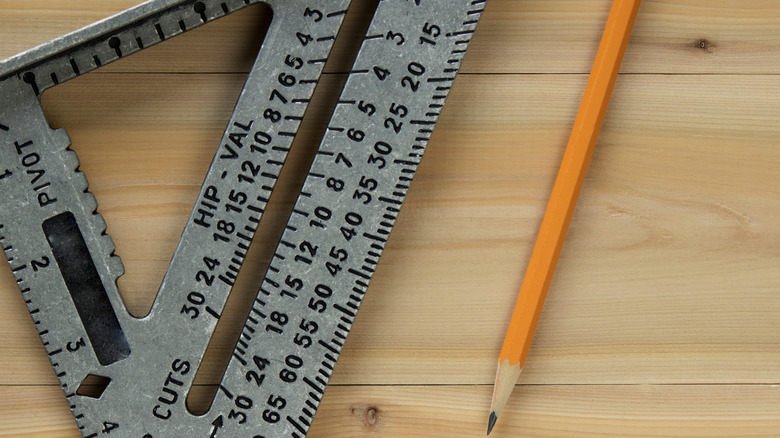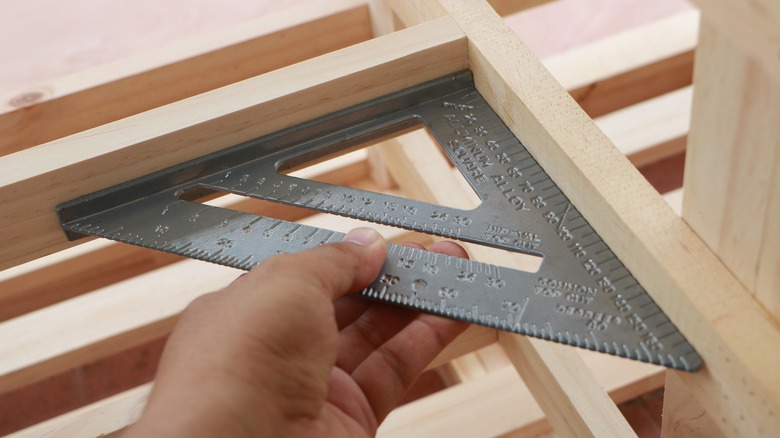Speed Square Basics You'll Want To Know For Your Next Wood DIY
The carpenter's square (also known as a rafter square but most commonly referred to as a Speed Square, a trademark of the Swanson Tool Co.) might be the most versatile tool in any toolbox. That's quite a claim, and it's quite a tool. Lots of us learned, somewhere along the way, to use them to mark right angles on boards we're about to cut, but TikTokker @woodshopdiaries has another use in mind. In a post labeled "speed square basics," she explains that you can also mark any angle from 0 to 90° using a carpenter's square. And that's just scratching the surface of the tool. Who knew you had a protractor in your toolbox all along?
The carpenter's square is all about the angles. It is probably most-used as a layout tool for marking 45° and 90° angles with pencil or other marking tool, or for hacks like scoring materials like vinyl plank flooring. The square is fundamentally a right triangle (with angles of 90°, 45°, and 45°), and can be used both to mark and verify squareness of cuts, a function that's also sometimes built into handsaws as a time-saver. So if things aren't lining up right, you can use its 90° corner to check that the board is cut at 90°. It can also verify the squareness of other things, such as confirming that your saw blade is 90° to the saw's shoe, or that your miter saw is properly set at 45°.
Carpenter's squares and geometry
The way @woodshopdiaries marks her angles using marks on the hypotenuse side (the longest side, opposite the right angle) that show 0-90° angles relative to the T-shaped edge of the square. With the T-edge flush against your material and the square's pivot point at the starting point of your cut, pivot the square so that the desired angle lines up with the edge of your workpiece. Then simply mark the angle along the ruler edge of the square. (You can also measure angles this way.)
You can also draw circles, create lines parallel to a board's edge, and do other nifty tricks with your square. There is an inner cutout within carpenter's squares, usually with one edge that appears serrated. These "serrations" are actually guides for pencils; simply place your pencil point in a cutout at the desired distance from the T-edge and rotate around the square's pivot point. There are better tools for marking circles, but this one's likely to be in your toolbelt already and it does a creditable job if used carefully. These inner points can also be used to mark parallel lines at specific distances from the T-edge by hooking the T-edge on your board's edge, putting your pencil in the cutout, and moving the square and pencil along the edge, using the T-edge as a guide. It's not as precise as the combination square we recommend as a good tool investment for DIYers, but it's fast and easy.
Other hidden carpenter's square basics
There are many other uses for the carpenter's square. It can be used as a fence to guide a circular saw when making 90° or 45° cuts, as long as the square is thick enough for your saw's shoe. Consider using a 12-inch model rather than the more common 7-inch square, since the larger one gives your saw more contact with the improvised fence. And use a plastic square if you have one, since accidentally making blade contact with a plastic square is safer than making contact with an aluminum square.
In combination with a plumb bob, it's possible to use a carpenter's square without a built-in level to confirm the levelness of a board. Starting a plumb bob line from the pivot point at the edge of your board, you can use the angle-measuring edge to determine if the board is level; the line will cross 45° if so. But a cheap bullet level will do as good a job, is lighter than a plumb bob, and is far less complicated to use.
The term "rafter square", hinting at its value in the roofing trade. These are more specialized uses than the average DIYer will often need, except maybe determining the pitch of a roof or staircase, which can be handy. Swanson published a 42-page book detailing the uses, mostly in roofing, for their Speed Square, and it's worth a look as an artifact of this particular branch of tradecraft.

